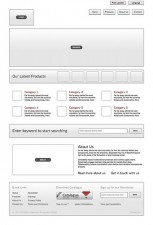Yesterday we talked about the SEO importance of longtail keywords and explained just how you get far more traffic from the longtail than you do from the big money terms. So if the longtail is that important, how do we go about optimizing our site for the longtail? If you have a site with thousands or tens or hundreds of thousands of keywords there is no possible way for you to manually do SEO for all of them!
 Fortunately, ranking for longtails keywords is comparatively easy. Since longtail keywords by definition have very few searches, it’s not only not worth your time to optimize a page around each phrase, it’s not worth anyone else’s time either. What this means is that longtail keywords are very low competition keywords, and are very easy to rank for with minimal SEO effort, that can be implemented on a site-wide scale, rather than a page by page strategy that is impractical.
Fortunately, ranking for longtails keywords is comparatively easy. Since longtail keywords by definition have very few searches, it’s not only not worth your time to optimize a page around each phrase, it’s not worth anyone else’s time either. What this means is that longtail keywords are very low competition keywords, and are very easy to rank for with minimal SEO effort, that can be implemented on a site-wide scale, rather than a page by page strategy that is impractical.
Here are three techniques to ensure that your site is maximizing your ability to bring in all that longtail traffic:
Lots of Detailed Content = Longtail SEO

The number one way to rank for all that juicy longtail starts with your content. Good longtail SEO means great content on your site: lots of it, and good detail on it all. Put bluntly, you are not going to rank for any word that you don’t have on your page. The more detail you go into, the greater the chances that you have to pick up a few specific words that someone is searching for.
If you have an ecommerce site, be sure to go into as much product detail as possible. There will be people who search for odd details, including exact measurements and materials. If you sell truck door seals, for example, you’ll find some people search for “metal truck door seals” or “truck door seals for US railroad containers” or even “3.5 inch plastic truck seals for freight shipping.”
In a more industrial example if you’re a metal forging company you’ll get people searching for your head terms — forging, custom forging, open die forging — but also searching for specific grades of metal, sizes, and delivery times.
Some examples of the kinds of information you want to include in product and services descriptions could include:
- Measurements for products or size capabilities for manufacturing services
- Material types: describe what the product is made of, in detail. Or describe what kinds of materials you work with, again doing into detail of types of metal grades.
- Applications — industries that make use of the product or service and exactly what they will use it for. For manufacturing the more examples of specific product types you have the more longtail you are capable of attracting. Don’t just say that your machining can be used in the aerospace industry, give a list of the kinds of things the aerospace industry uses that machining for, in as much detail as possible.
- Include common high-conversion terms somewhere on the page. Even if the search volume is low, some people will search that way and are very likely to buy. These include “where to, buy, find, for sale.” Even working each of those words in once will give you access to some very high quality longtail variations (though for many B2C sites those phrases are in the head).
- Synonyms: don’t just pound on your head keywords over and over and over. Use all the common synonyms at least once on the page. Don’t just describe a “wood pallet” — include “wooden, plywood” etc.
The more detail you go into, the more longtail searches you have the capability of ranking for — but only if you’re genuinely providing information. You can’t just take the same description and slightly tweak it and regurgitate it on page after page (avoiding duplicate content filters, but not saying anything new). If you aren’t saying new things, new words, you aren’t increasing your ability to attract longtail queries.
This rule doesn’t just apply to descriptions of products and services, but to all pages on your site. If you have a news section, be sure to talk about diverse news items in detail, as much detail as is reasonable. If you have a blog, that is the ideal way to attract tons of phrases by talking about specific products or processes or customer solutions.
Final takeaway on this one: you need lots of detailed content. That doesn’t necessarily mean lots of words (though it often does). Don’t worry about inflating word count, because you’ll often end up saying a lot of nothing, and most filler phrases aren’t going to help you.
Smart Naming & Site Structure
 Sites selling a huge number of products are often just too big with too many pages to write a lot of detailed content for every single product.
Sites selling a huge number of products are often just too big with too many pages to write a lot of detailed content for every single product.
For example, if you sell hardware and have 571 different kinds of screws and 1,079 different kinds of washers, there’s no way you’re going to write up a detailed list of possible uses for every single one for your SEO. In fact, it’s probably unreasonable to expect anything other than a spec list for each product.
However, you can do wonders for your longtail just by using intelligent naming and site structure practices. This all starts with naming your products intelligently, with SEO in mind. The value of well-named products cannot be overstated — by putting your time in on naming things well you will greatly increase the SEO benefits to your site and hugely decrease the amount of work you’ll have to do later to optimize your longtail traffic.
Page & product naming guidelines:
- Descriptive Names: name your part or product descriptively. For our hardware example, don’t just call the washers “washer1, washer2”. Call them “3.14 cm aluminum washer” (or something even more useful, if you know more about hardware than I do). Almost anything that you’re likely to list in the specs is a good candidate for the name.
- Part Numbers: Part numbers are good and should be included in the name, but should not be the only thing. “MX5771” alone is a horrible name, but “MX5771 3.14 cm aluminum washer” is fantastic.
- Brand Names: just like the part number, don’t use your brand name alone in the product name. If you sell dice and you have the awesome new Blue Lightning dice, just using “Blue Lightning” is not a great name for a page. Instead use “Blue Lightning 16mm 6-sided dice” and you’ll be far more likely to rank better for a wider range of searches.
Naming your products well is a huge element, particularly for very large shopping cart or RFQ cart sites, but you also need to make sure your site structure takes advantage of this. In particular, make sure that your Title and Meta Description tags do a good job of pulling in this information.
Site Structure Guidelines:
- Your Title should pull in the product name, brand, and part number into the title tag — all elements that are relevant. If you’re already pulling multiple of those elements into your product name (as you should!) then the product name alone can populate the Title tag. Don’t forget to add your site name to the end (not the beginning) of that title tag. Your Title tag is the most important SEO element on your page, and you want to leverage that.
- Your Meta Description tag should fill in useful and unique information from the page. Do not just use a generic Meta Description for all the pages! In the best case scenario you can write a script and let your backend fill in the blanks, like a MadLib. So your Meta Description might be “Low cost [name] from Acme, Inc with same day shipping on all [category] orders.” For our hardware example this is now “Low cost 3.14 cm aluminum washers from Acme, Inc with same day shipping on all Washers orders.”
- Images should all have descriptive and SEO beneficial alt tags. With good naming policies, you can just pull the name (or part number + name) in as the alt tag.
- If possible, be sure to have automated cross linking in your products. This is often accomplished through a “Related Products” section.
Your site should also have a logical hierarchy structure, of course, with each sub-category linking to the parent category and each product linking to it’s sub-category. For huge database sites, the combination of quality naming policies and logical Title and Meta Description tags will go a long way to increasing your longtail searches.
Optimize for the Head and the Tail Will Follow
The final key method for optimizing for the longtail is just to focus your SEO efforts on optimizing for your head terms. The reason this works is that most longtail keywords are variations on your head keyword phrases. So in our custom forging example, you’ll have a whole host of longtail keywords like “custom forging with short lead times, 13-8 vim/var steel forging custom.”
Now you aren’t going to rank for those longtail unless you actually use those terms (short lead times, steel grades) but as long as those are on the page, then continuing your SEO efforts to optimize and build links for your head keyword “custom forging” will in turn help out all of the longtail phrases with “custom forging” somewhere in the keyword phrase.
This is where it’s useful to track not just your head keyword phrases, but also to track the total number of different keywords that are driving traffic to your site. If you have built your site well to attract the longtail — good detailed content, good naming, good site structure — then as your ranking for head phrases improves, you should also see the total number of different keywords driving traffic to your site increase as well.






